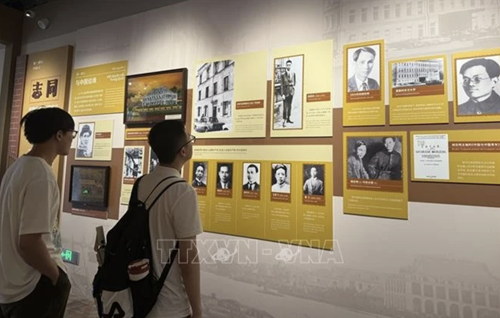During his journey to seek a path for liberating the nation, President Ho Chi Minh spent many years in China, including an extremely important period in Guangzhou, Guangdong province from 1924–1927. During this time, he set up the Vietnam Revolutionary Youth League, the predecessor of the Communist Party of Vietnam (CPV), and organized training courses to prepare personnel and build the organizational structure, creating the ideal conditions for the founding of the CPV — the core leadership and decisive factor in the success of the Vietnamese revolution.
    |
 |
|
Visitors at the exhibition |
Notably, during this time, President Ho Chi Minh directed the founding of Thanh Nien (Young people) Newspaper, which laid the foundation for Vietnam’s revolutionary press, playing a vital role in disseminating revolutionary ideas, mobilizing the masses, and organizing and leading the Vietnamese revolutionary movement.
The exhibition retraces the late Vietnamese leader’s 12 years of revolutionary activities in China through four thematic sections, including close bonds, and a glorious chapter in Vietnam–China friendship. During his time in China, President Ho Chi Minh travelled to locations such as Guangzhou, Hong Kong, Guilin, Chongqing, Kunming, Jingxi, Liuzhou, and Longzhou.
The exhibits at the event emphasized that, under the leadership of President Ho Chi Minh, late Chinese President Mao Zedong, and other pioneering leaders, the people of Vietnam and China stood together, enduring hardships in their struggles for independence and national liberation. The friendship as comrades plus brothers between Vietnam and China remains a valuable legacy for both nations and will endure for future generations.
After the establishment of diplomatic relations in 1950, President Mao Zedong, President Ho Chi Minh, and other senior leaders from both countries made friendly visits and exchanges, directly contributing to the development and strengthening of the traditional friendship between the two nations.
Historical sites associated with the revolutionary career of President Ho Chi Minh in China are evidence of his revolutionary journey and serve as important landmarks of Vietnam–China friendship. The Chinese government attaches great importance to preserving these sites, having restored and protected them to enhance their historical value. Today, they serve as “red addresses,” destinations for revolutionary education and people-to-people exchanges, especially among younger generations.
The exhibition is scheduled to be held on a rotating basis at several museums in both Vietnam and China. It is expected to contribute to further deepening the deep-rooted solidarity and traditional friendship between the two countries.
Source: VNA